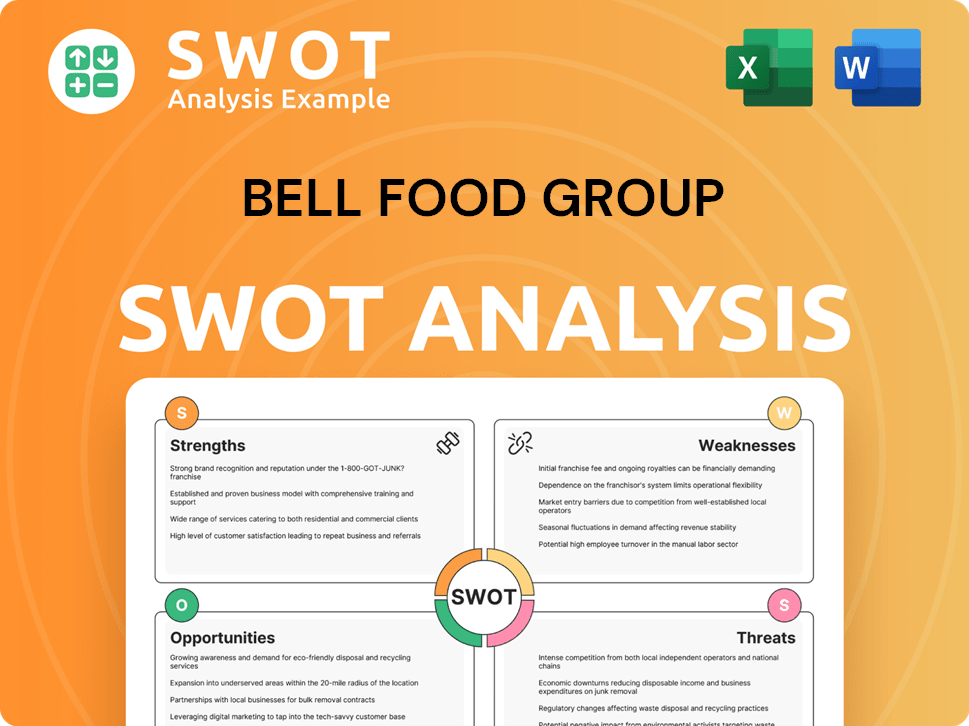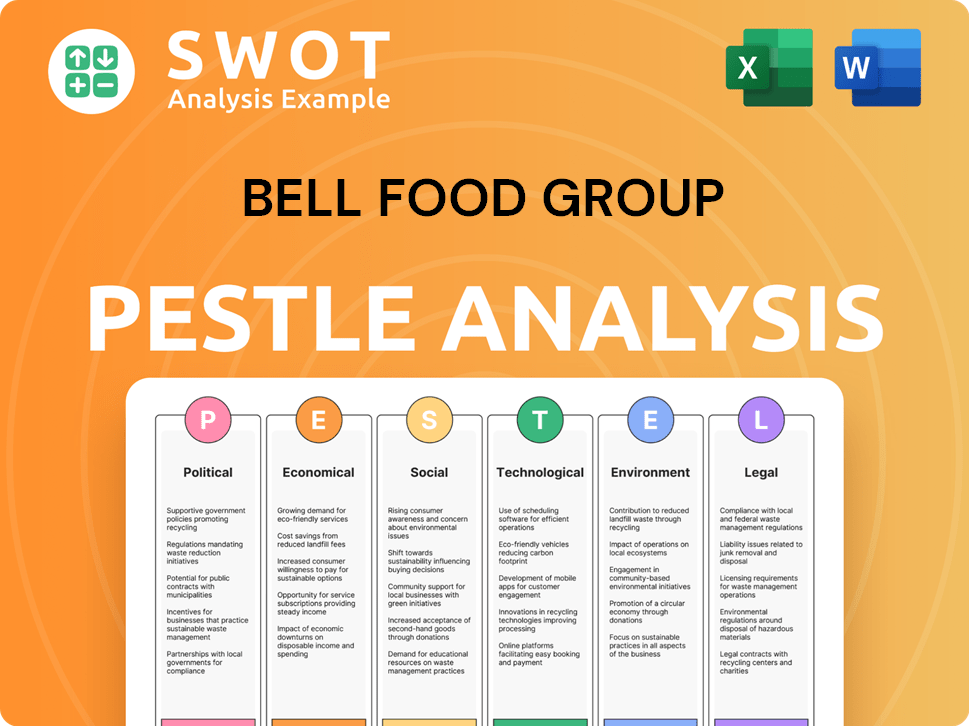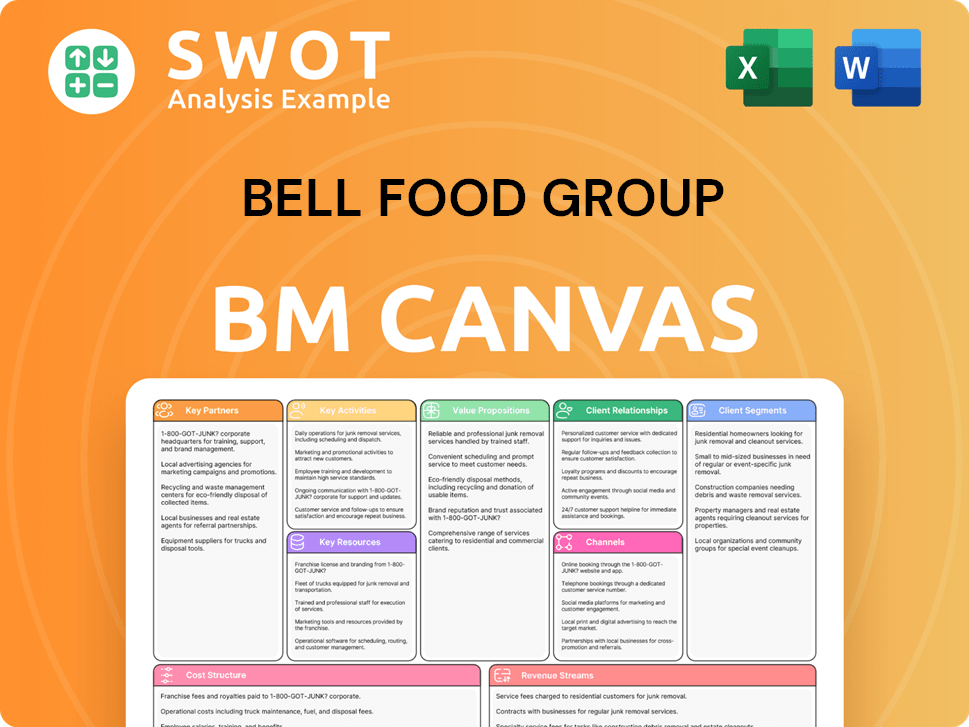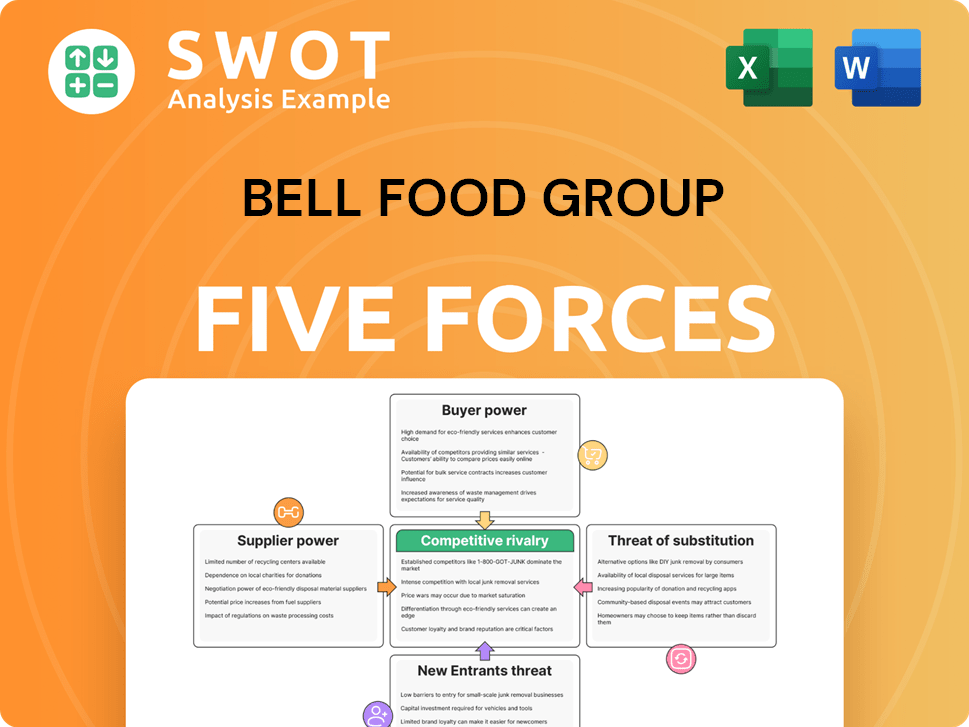Bell Food Group Bundle
How Does Bell Food Group Dominate the European Food Market?
In the cutthroat world of European food, understanding the Bell Food Group SWOT Analysis is key to unlocking its success. From its humble beginnings as a Swiss butcher shop, Bell Food Group has transformed into a powerhouse, but how did it achieve this? This exploration delves into the company's dynamic sales and marketing strategies, revealing the secrets behind its sustained growth and market leadership.

This analysis will dissect Bell Food Group's sales strategy and marketing strategy, examining how this Swiss company effectively navigates the food industry. We'll uncover the specific tactics used to build brand awareness, drive sales, and strategically position its core brands. Furthermore, we'll explore its business strategy and recent marketing campaigns to provide actionable insights for investors and industry professionals.
How Does Bell Food Group Reach Its Customers?
The sales channels employed by Bell Food Group are multifaceted, designed to ensure its products reach a broad consumer base across Europe. The company's approach combines traditional retail partnerships with the evolving landscape of digital commerce. This strategy is crucial for maintaining a strong market presence and adapting to changing consumer behaviors within the food industry.
Bell Food Group's distribution network is primarily anchored by strong relationships with major retail chains and supermarkets. These partnerships are essential for the widespread availability of products under brands such as Bell, Hilcona, Eisberg, and Hügli. Complementing this, the company also utilizes wholesale channels to supply food service providers, including restaurants and catering companies, especially for its convenience food offerings. This dual approach allows Bell Food Group to effectively capture both in-home and out-of-home consumption markets.
The company's sales strategy has seen a strategic shift towards omnichannel integration and digital adoption. While traditional retail remains dominant, Bell Food Group has increasingly explored and leveraged online channels. This includes supplying products to major online grocery platforms and, in some instances, developing direct-to-consumer (DTC) e-commerce capabilities, although the extent of DTC varies by brand and region. The introduction of these digital channels has been driven by changing consumer shopping habits, particularly the accelerated adoption of online grocery shopping observed in recent years.
Bell Food Group's success hinges on its robust partnerships with major retail chains and supermarkets. These relationships facilitate the broad distribution of products, ensuring they are readily available to consumers across various markets. This extensive reach is a cornerstone of the company's sales strategy.
The company also engages in wholesale distribution, supplying food service providers like restaurants and hotels. This channel is particularly important for its convenience food offerings, allowing Bell Food Group to capture a significant share of the out-of-home consumption market. This B2B segment is a key component of their overall business strategy.
Bell Food Group has embraced digital channels, including online grocery platforms and DTC e-commerce. This shift reflects changing consumer behavior and the growing importance of online shopping. The company continuously monitors and optimizes its logistics to ensure seamless delivery across both online and offline touchpoints.
The performance of all sales channels is continuously monitored, with a focus on optimizing logistics and supply chains. This ensures efficient delivery and supports the company's ability to maintain a strong market share. Key partnerships with large retail groups and food service distributors have been instrumental in Bell Food Group's growth.
Bell Food Group's success is significantly influenced by its strategic partnerships with major retail groups and food service distributors. These collaborations are vital for maintaining a strong market share in a competitive environment. For instance, the company's sales volume in 2023 was 468,500 tonnes, demonstrating the effectiveness of its distribution network, as highlighted in Revenue Streams & Business Model of Bell Food Group.
- Retail partnerships ensure widespread product availability.
- Wholesale channels target the out-of-home consumption market.
- Digital adoption enhances market reach and customer engagement.
- Continuous monitoring optimizes sales performance and logistics.
Bell Food Group SWOT Analysis
- Complete SWOT Breakdown
- Fully Customizable
- Editable in Excel & Word
- Professional Formatting
- Investor-Ready Format

What Marketing Tactics Does Bell Food Group Use?
The marketing tactics employed by the company are multifaceted, designed to boost brand awareness, stimulate demand, and increase sales. The company's approach blends digital and traditional marketing methods to reach a broad consumer base. The company utilizes a data-driven approach, tailoring messages to specific consumer segments.
Digital marketing initiatives are crucial, with content marketing, SEO, and paid advertising playing significant roles. Social media platforms are actively used for community engagement. Traditional media, such as TV and print, are still leveraged to reinforce brand messaging. Participation in industry events is also a key part of the marketing strategy.
The company's marketing strategy is dynamic, adapting to the evolving media landscape. The focus is on creating engaging content, optimizing online visibility, and leveraging data analytics to refine campaigns and enhance customer engagement. This approach is essential for maintaining a competitive edge in the food industry.
The company leverages digital channels extensively. Content marketing, SEO, and paid advertising are key components of their digital strategy. Email marketing and social media engagement are also utilized to connect with customers.
Content marketing involves creating engaging content. This includes recipes, nutritional information, and details on sustainable practices. This helps to build brand awareness and connect with consumers.
SEO is used to improve search visibility. Paid advertising, including SEM and display ads, targets specific consumer segments. These tactics drive traffic and sales.
Social media platforms are used for community engagement and brand storytelling. Email marketing offers promotions and exclusive content. These channels foster customer relationships.
Traditional media outlets are still utilized. TV, radio, and print advertising are used for broad reach. This reinforces brand messaging and supports overall marketing efforts.
The company utilizes customer segmentation. Advanced analytics tools track campaign performance and measure ROI. This data-driven approach helps tailor messages effectively.
The company's marketing strategy is designed to enhance its market position. By combining digital and traditional methods, the company aims to reach a wide audience and build strong brand loyalty. The use of data analytics ensures that marketing efforts are targeted and effective, contributing to the overall Target Market of Bell Food Group success. The company's focus on innovation and sustainability also plays a role in its marketing campaigns, resonating with consumers who value these aspects. The company's commitment to a comprehensive marketing strategy is essential for sustained growth and competitiveness in the food industry.
The company employs a variety of marketing tactics to build brand awareness and drive sales. These tactics include digital marketing, content creation, and traditional advertising. The use of data analytics helps to refine these strategies.
- Content Marketing: Creation of engaging content around recipes and nutritional information.
- SEO: Optimizing websites for high visibility in search results.
- Paid Advertising: Utilizing SEM and display advertising on various platforms.
- Email Marketing: Direct communication with customers through promotions and announcements.
- Social Media: Active engagement on platforms like Facebook and Instagram.
- Traditional Media: Leveraging TV, radio, and print for broad reach.
- Events: Participating in food industry events and trade shows.
- Data Analytics: Using customer segmentation and analytics tools to measure ROI.
Bell Food Group PESTLE Analysis
- Covers All 6 PESTLE Categories
- No Research Needed – Save Hours of Work
- Built by Experts, Trusted by Consultants
- Instant Download, Ready to Use
- 100% Editable, Fully Customizable

How Is Bell Food Group Positioned in the Market?
The brand positioning of the Bell Food Group is a critical element of its Growth Strategy of Bell Food Group within the competitive food industry. The company strategically positions its core brands—Bell, Hilcona, Eisberg, and Hügli—to cater to diverse consumer preferences and market segments. This approach allows the company to maintain a strong presence and adapt to the evolving demands of the European food market.
The overarching strategy focuses on communicating quality, freshness, and convenience across its product lines. Each brand has a distinct identity that resonates with its target audience. This multi-brand strategy allows the Bell Food Group to address various consumer needs, from traditional meat products to innovative convenience foods and health-focused options.
The company's focus on sustainability, aiming to reduce CO2 emissions by 50% by 2030, further enhances its brand appeal, particularly among environmentally conscious consumers. This commitment is part of a broader effort to maintain brand consistency across all channels, ensuring a cohesive customer experience from packaging to digital advertising.
The Bell brand emphasizes its heritage in meat processing, communicating reliability and traditional craftsmanship. Hilcona is positioned as a leader in fresh convenience foods, highlighting innovation and speed. Eisberg focuses on fresh salads and prepared vegetables, emphasizing health and ease of use.
The core message across the group's brands centers on providing enjoyable and easy meal solutions that meet modern consumer demands. The brands maintain distinct identities while sharing a subtle theme of freshness and quality. The tone of voice varies to match the brand's target audience.
The company appeals to its target audience through a combination of attributes, often emphasizing the provenance of its ingredients and sustainable practices. The convenience factor is also a key element in their marketing strategy. The focus is on meeting the needs of busy consumers.
In 2023, the Bell Food Group reported a net sales increase of 0.7%, reaching CHF 4.3 billion, indicating the effectiveness of its brand positioning and market strategies. This financial performance demonstrates the success of their sales and marketing strategy.
Bell Food Group Business Model Canvas
- Complete 9-Block Business Model Canvas
- Effortlessly Communicate Your Business Strategy
- Investor-Ready BMC Format
- 100% Editable and Customizable
- Clear and Structured Layout

What Are Bell Food Group’s Most Notable Campaigns?
The sales and marketing strategy of the company, a prominent player in the food industry, is multifaceted, focusing on brand building, product innovation, and market penetration. Understanding the key campaigns provides insights into how the company achieves its business goals. The company's approach involves a blend of traditional and digital marketing techniques, tailored to reach diverse consumer segments.
The company's sales strategy leverages its strong brand reputation and extensive distribution network to drive sales. The marketing strategy aims to enhance brand awareness, customer loyalty, and market share. The company's campaigns are often aligned with seasonal events, product launches, and sustainability initiatives to resonate with consumers.
The company's marketing campaigns are designed to increase product visibility and drive sales. The company focuses on digital marketing, in-store promotions, and collaborations with chefs to reach its target market. The company also emphasizes sustainability in its marketing efforts to attract environmentally conscious consumers. These strategies are essential for maintaining a competitive edge in the dynamic food industry.
For the brand Hilcona, a key campaign might center around launching new ready-meal lines. This would emphasize innovative recipes and plant-based options. The campaign would aim to boost sales in the convenience food segment.
Digital channels would be heavily utilized, including social media ads, collaborations with food bloggers, and recipe content on the company's website. In-store promotions and TV spots during cooking shows could also be part of the strategy. Success would be measured by sales lift and social media engagement.
For the brand, campaigns might highlight the quality and origin of its meat products, coinciding with grilling season or holidays. The objectives include reinforcing brand loyalty and driving sales of specific meat cuts. The company uses traditional print advertisements in food magazines.
Given the company's focus on sustainability, campaigns highlighting animal welfare or reducing environmental impact could be significant. This aims to enhance brand perception and appeal to ethically conscious consumers. In 2023, retail sales in the segment grew by 2.6%, indicating successful campaigns.
The company utilizes a variety of channels to execute its marketing campaigns effectively, ensuring broad reach and engagement with its target audiences. These channels are chosen to maximize impact and drive sales across different product lines. The company's approach includes a mix of traditional and digital methods.
- Digital Marketing: Social media advertising, targeted online content, and collaborations with influencers.
- In-Store Promotions: Eye-catching displays, special offers, and recipe cards to drive impulse purchases.
- Traditional Media: Print advertisements in food magazines and potential TV spots during cooking shows.
- Public Relations: Collaborations with chefs and food personalities to enhance brand credibility.
The sales strategy for meat products focuses on highlighting quality and origin. This includes in-store promotions and digital content. The company aims to reinforce brand loyalty and drive sales.
The marketing strategy for processed foods involves showcasing convenience and gourmet quality. The company uses digital channels, in-store promotions, and collaborations. The focus is on increasing product awareness and driving trial.
The brand positioning strategy emphasizes product quality, origin, and sustainability. Campaigns are designed to resonate with consumer values. The company aims to build a strong brand reputation.
Digital marketing initiatives include social media campaigns, recipe content, and collaborations. The company uses these initiatives to increase online visibility and drive sales. This approach enhances customer engagement.
Customer relationship management focuses on building brand loyalty through targeted campaigns. The company uses data to understand customer preferences. This approach improves customer satisfaction.
Sustainability marketing highlights the company's efforts in animal welfare and environmental impact. This aims to attract ethically conscious consumers and enhance brand perception. The company's commitment to sustainability is a key differentiator.
The company's sales and marketing strategies are integral to its success in the competitive food industry. By focusing on key campaigns, the company strengthens its brand and drives sales. For a deeper understanding of the company's history and evolution, consider reading the Brief History of Bell Food Group.
Bell Food Group Porter's Five Forces Analysis
- Covers All 5 Competitive Forces in Detail
- Structured for Consultants, Students, and Founders
- 100% Editable in Microsoft Word & Excel
- Instant Digital Download – Use Immediately
- Compatible with Mac & PC – Fully Unlocked

Related Blogs
- What are Mission Vision & Core Values of Bell Food Group Company?
- What is Competitive Landscape of Bell Food Group Company?
- What is Growth Strategy and Future Prospects of Bell Food Group Company?
- How Does Bell Food Group Company Work?
- What is Brief History of Bell Food Group Company?
- Who Owns Bell Food Group Company?
- What is Customer Demographics and Target Market of Bell Food Group Company?
Disclaimer
All information, articles, and product details provided on this website are for general informational and educational purposes only. We do not claim any ownership over, nor do we intend to infringe upon, any trademarks, copyrights, logos, brand names, or other intellectual property mentioned or depicted on this site. Such intellectual property remains the property of its respective owners, and any references here are made solely for identification or informational purposes, without implying any affiliation, endorsement, or partnership.
We make no representations or warranties, express or implied, regarding the accuracy, completeness, or suitability of any content or products presented. Nothing on this website should be construed as legal, tax, investment, financial, medical, or other professional advice. In addition, no part of this site—including articles or product references—constitutes a solicitation, recommendation, endorsement, advertisement, or offer to buy or sell any securities, franchises, or other financial instruments, particularly in jurisdictions where such activity would be unlawful.
All content is of a general nature and may not address the specific circumstances of any individual or entity. It is not a substitute for professional advice or services. Any actions you take based on the information provided here are strictly at your own risk. You accept full responsibility for any decisions or outcomes arising from your use of this website and agree to release us from any liability in connection with your use of, or reliance upon, the content or products found herein.